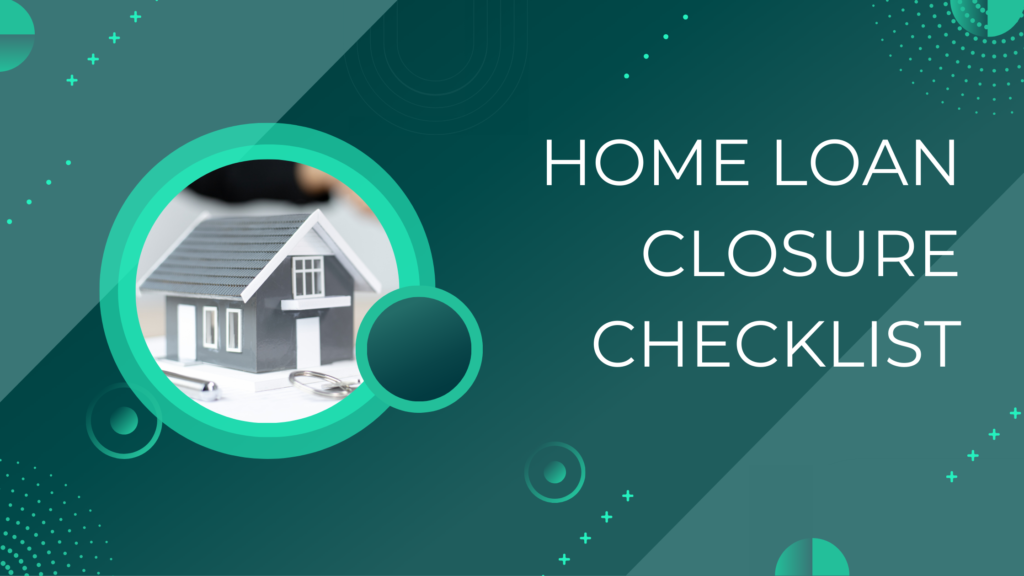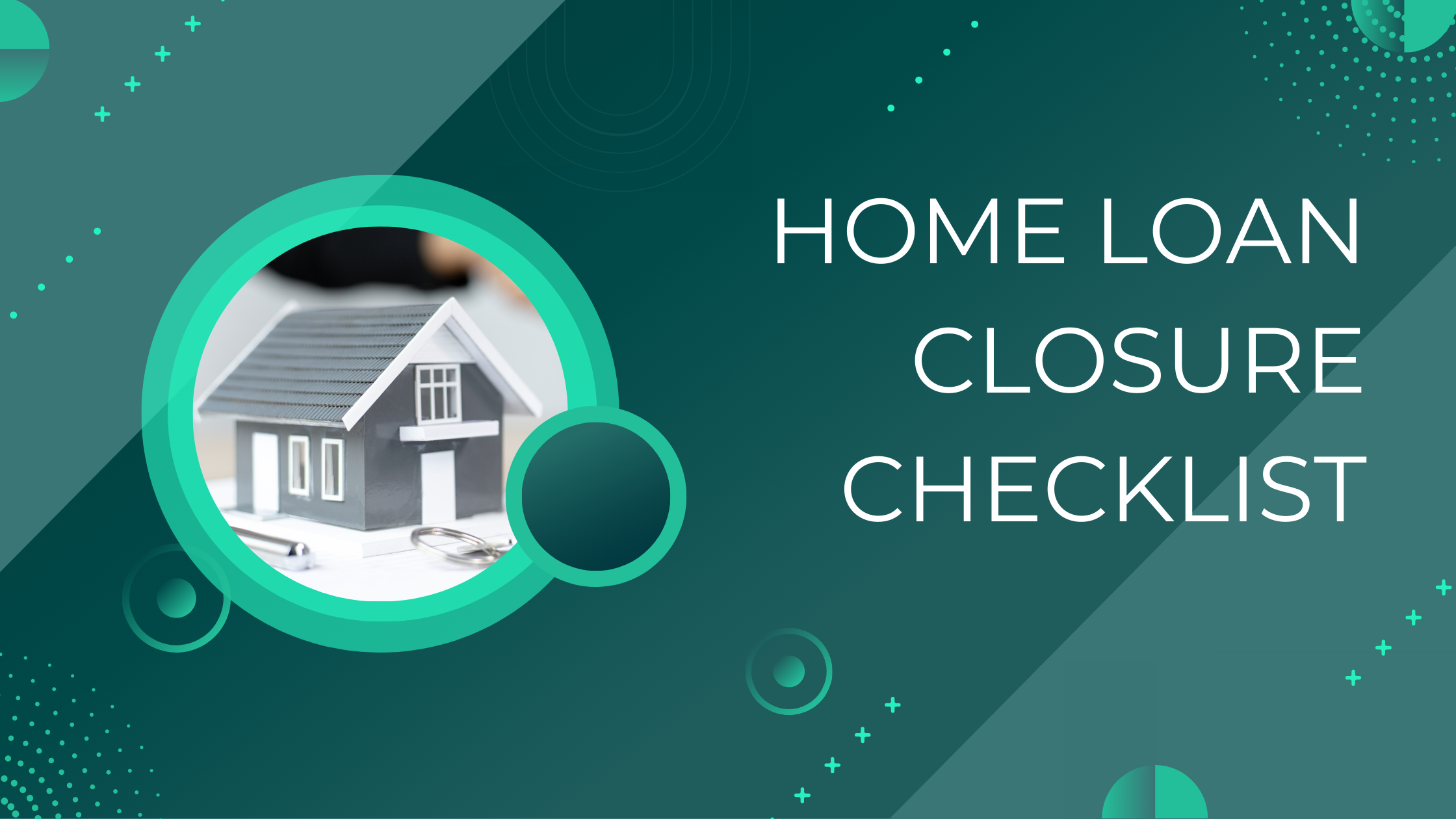“The Ultimate Home Loan Closure Checklist” – A comprehensive guide to closing your home loan smoothly. Learn key steps, essential documents, and tips to avoid common pitfalls. Ensure a hassle-free loan closure with our detailed checklist.

- Introduction
- Overview of Home Loan Closure
- Importance of a Home Loan Closure Checklist
- Understanding the Home Loan Closure Process
- What is Home Loan Closure?
- Key Steps in the Home Loan Closure Process
- Pre-Closure Requirements
- Reviewing the Loan Agreement
- Clearing All Outstanding Dues
- Arranging Necessary Documents
- Types of Home Loan Closures
- Regular Closure
- Prepayment or Foreclosure
- Partial Closure
- Checklist for Regular Home Loan Closure
- Paying the Final EMI
- Verifying Payment Acknowledgment
- Requesting a No Objection Certificate (NOC)
- Checklist for Prepayment or Foreclosure
- Informing the Lender
- Calculating Prepayment Charges
- Completing the Foreclosure Process
- Checklist for Partial Closure
- Understanding Partial Prepayment
- Coordinating with the Bank
- Monitoring EMI Adjustments
- Post-Closure Documentation
- Retrieving the Title Deed
- Collecting Other Important Documents
- Updating Credit Bureau Records
- Ensuring No Dues Certificate (NDC)
- Importance of NDC
- How to Obtain an NDC
- Verifying Credit Score After Closure
- Impact of Loan Closure on Credit Score
- Steps to Check and Correct Credit Score
- Handling Discrepancies Post-Closure
- Common Post-Closure Issues
- Resolving Discrepancies with the Bank
- Impact of Home Loan Closure on Taxation
- Tax Benefits on Home Loans
- Tax Implications After Closure
- Tips for a Smooth Home Loan Closure
- Maintaining Clear Communication with the Lender
- Regularly Monitoring Your Loan Account
- FAQs about Home Loan Closure
- What Happens if There’s a Delay in Closure?
- Can I Reopen a Closed Home Loan?
- Conclusion
- Summarizing the Importance of a Home Loan Closure Checklist
- Final Thoughts

The Ultimate Home Loan Closure Checklist
Introduction
Closing a home loan is a significant milestone in anyone’s financial journey. It marks the end of a long-term commitment and the beginning of true homeownership. However, the process of closing a home loan can be intricate, with several steps that need careful attention. That’s where a home loan closure checklist comes into play. In this article, we’ll guide you through every step necessary to ensure a smooth and hassle-free home loan closure.
Understanding the Home Loan Closure Process
What is Home Loan Closure?
Home loan closure, also known as loan repayment or settlement, is the process of paying off the entire loan amount, including interest, to the lender. This can happen at the end of the loan tenure or earlier through prepayment or foreclosure.
Key Steps in the Home Loan Closure Process
The process involves several steps, from ensuring all dues are paid to retrieving important documents from the lender. Each step is crucial to prevent any legal or financial complications in the future.
Pre-Closure Requirements
Reviewing the Loan Agreement
Before initiating the closure, it’s essential to revisit your loan agreement. Understanding the terms and conditions related to closure will help you avoid any hidden charges or penalties.
Clearing All Outstanding Dues
Ensure that all your EMIs (Equated Monthly Installments) are paid up to date. Any pending dues must be cleared before you can proceed with the closure.
Arranging Necessary Documents
Gather all the necessary documents such as loan statements, payment receipts, and identity proofs. These will be required at various stages of the closure process.
Types of Home Loan Closures
When closing a home loan, there are three primary methods to consider: Regular Closure, Prepayment or Foreclosure, and Partial Closure. Each type has its own process and implications.
Regular Closure
Regular closure occurs when the loan is paid off as per the original repayment schedule. You continue to pay your EMIs (Equated Monthly Installments) until the end of the loan tenure, after which the loan is fully settled.
Prepayment or Foreclosure
Prepayment or foreclosure allows you to repay the loan before the end of the tenure. This can be done either partially or in full, depending on your financial situation. While this can save you on interest costs, some lenders may charge a prepayment penalty.
Partial Closure
Partial closure involves making a lump sum payment towards the principal amount, which reduces the overall loan balance. This can lead to either a lower EMI or a shorter loan tenure, depending on the agreement with your lender.
Checklist for Regular Home Loan Closure
Paying the Final EMI
Make sure that the final EMI is paid on time. Delays in the final payment can lead to penalties and complications in the closure process.
Verifying Payment Acknowledgment
After paying the final EMI, obtain a payment acknowledgment from the lender. This serves as proof that all dues have been cleared.
Requesting a No Objection Certificate (NOC)
An NOC is a crucial document that certifies you have repaid the loan in full. Request this from your lender as soon as the final payment is made.
Checklist for Prepayment or Foreclosure
Informing the Lender
If you plan to prepay or foreclose your loan, inform your lender in advance. This will allow them to calculate any prepayment charges or penalties.
Calculating Prepayment Charges
Some lenders impose a penalty for prepaying a loan. Ensure you are aware of these charges and factor them into your decision.
Completing the Foreclosure Process
Once the prepayment is made, complete any formalities with the lender, including signing any required documents to officially close the loan.
Checklist for Partial Closure
Understanding Partial Prepayment
Partial prepayment allows you to reduce the principal amount of the loan, which in turn reduces your EMI or loan tenure. Understand how this impacts your overall loan before proceeding.
Coordinating with the Bank
Inform your bank about your intent to make a partial payment and ensure they adjust the EMI or tenure accordingly.
Monitoring EMI Adjustments
After partial closure, keep an eye on your EMI deductions to ensure they reflect the reduced loan amount.
Post-Closure Documentation
Retrieving the Title Deed
Once the loan is closed, your lender is obligated to return the title deed of the property. This document is crucial as it proves your ownership.
Collecting Other Important Documents
In addition to the title deed, collect all other original documents submitted at the time of loan application, such as the sale deed and power of attorney.
Updating Credit Bureau Records
Ensure that your loan closure is reported to credit bureaus. This will help in maintaining or improving your credit score.
Ensuring No Dues Certificate (NDC)
Importance of NDC
The NDC is a certificate from the lender stating that there are no dues left on the loan. This is a critical document that serves as proof of loan closure.
How to Obtain an NDC
Request an NDC from your lender once the loan is closed. Keep this document safely, as it may be required in the future.
Verifying Credit Score After Closure
Impact of Loan Closure on Credit Score
Closing a home loan can have a positive impact on your credit score as it reduces your overall debt. However, it’s essential to verify this by checking your credit report.
Steps to Check and Correct Credit Score
After loan closure, check your credit report for accuracy. If there are any discrepancies, report them to the credit bureau for correction.
Handling Discrepancies Post-Closure
Common Post-Closure Issues
Sometimes, even after closing a loan, issues like delayed updates in credit reports or errors in documentation can arise. These need to be addressed promptly.
Resolving Discrepancies with the Bank
If you encounter any discrepancies, contact your lender immediately and provide the necessary documents to resolve the issue.
Impact of Home Loan Closure on Taxation
Tax Benefits on Home Loans
During the tenure of a home loan, you may be eligible for certain tax benefits under Sections 80C and 24(b) of the Income Tax Act.
Tax Implications After Closure
Once the loan is closed, these tax benefits cease. It’s important to adjust your tax planning accordingly.
Tips for a Smooth Home Loan Closure
Maintaining Clear Communication with the Lender
Regular communication with your lender ensures that you are aware of any outstanding dues or pending documents.
Regularly Monitoring Your Loan Account
Keep an eye on your loan account, especially towards the end of the tenure, to ensure that all payments are made and reflected correctly.
Conclusion
Closing a home loan is a detailed process that requires careful planning and attention to detail. By following the steps outlined in this checklist, you can ensure a smooth and hassle-free closure. Remember, the key to a successful home loan closure lies in being proactive, organized, and informed.
FAQs about Home Loan Closure
- What Happens if There’s a Delay in Closure?
- Delays can lead to additional interest or penalties, so it’s essential to close the loan on time.
- Can I Reopen a Closed Home Loan?
- No, once a loan is closed, it cannot be reopened. You would need to apply for a new loan.
- How Long Does It Take to Receive the Title Deed After Closure?
- It typically takes a few weeks, but this can vary depending on the lender.
- Are There Any Hidden Charges in the Home Loan Closure Process?
- Always check your loan agreement for any clauses related to closure fees or penalties.
- What Should I Do if My Credit Score Doesn’t Update After Closure?
- Contact the credit bureau and your lender to resolve the issue.


2 thoughts on “The Ultimate Guide to Seamless Home Loan Closure”